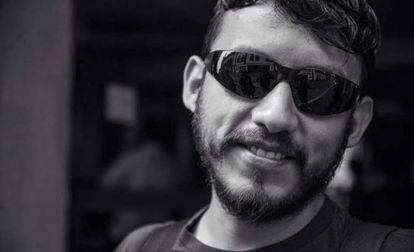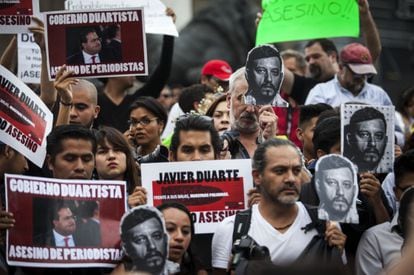Mexican journalist and four women shot in the head, say prosecutors
Rubén Espinosa’s murder underscores the growing danger for reporters in Mexico


Mexican authorities have confirmed that a 31-year-old photojournalist was shot dead on Friday night, along with four women, in an apartment in Mexico City.
Rubén Espinosa had sought refuge in the Mexican capital about a month ago, after he began feeling threatened by unknown figures in Veracruz state, where he worked.
Espinosa’s death brings to the forefront the danger Mexican journalists have faced over the years
His death brings to the forefront the danger Mexican journalists have faced over the years in their efforts to cover stories involving corruption, crime and drug-trafficking.
“All the bodies had gunshot wounds to the head and knife wounds in different areas,” said Mexico City prosecutor Rodolfo Ríos, adding that Espinoza and the four women were each given a coup de grâce.
Unofficial sources also suggested that all of the female victims had been raped.
Espinosa was a photographer for a number of media outlets, including newsweekly Proceso and Cuartoscuro news agency. He left Veracuz – considered the most dangerous place in Mexico for journalists to work – about a month ago after denouncing that he was being followed and photographed by unknown people.
While Ríos said that a full investigation into the murders would be carried out, the names of the four other victims were not released.
However, some of the identities were confirmed though other sources. One of the victims was Espinosa’s friend Nadia Vera, a 32-year-old anthropology graduate. She was an activist with the #YoSoy132 student group, which was organized before the 2012 presidential elections in an effort to demand transparency.
A second victim was identified as Yesenia Quiroz, an 18-year-old Colombian, while the two other women were not named. One of the victims was reportedly a housekeeper.

On Sunday, a neighbor in Mexico City’s Narvarte district, where Espinosa was staying, said he saw investigators examining the bound bodies of two women.
“The first one was on the bed with her legs tied with a grey strap, and a cable was wrapped around her head,” said the witness, who added that he didn’t hear any unusual sounds coming from the apartment on night of the killings. “When the investigators turned her around, her face was beaten.”
Espinosa was the seventh journalist killed in Mexico – a country that Reporters without Borders listed last year as one of the most dangerous nations for working journalists. According to the group, at least 100 reporters have been killed in Mexico since 2000.
In Veracuz alone, 15 journalists have died since 2011 during the mandate of a controversial governor
In Veracuz alone, 15 journalists have died since 2011 during the mandate of controversial governor Javier Duarte of the Institutional Revolutionary Party (PRI). A colleague at Proceso, Regina Martínez, was found strangled in her home in 2012.
Last month during an interview, Espinosa was critical of Duarte’s state government.
“It is sad to think that there are no words to describe how bad the state, government and press is, and how rampant corruption is. Death chose Veracuz and death has decided to remain there,” he said.
Prosecutor Rios met with members of press advocacy groups, such as Article 19 and Pen International, as well as officials from Proceso and Cuartoscuro to pledge his commitment to seeing the case solved.
Both Article 19 and the US-based Committee to Protect Journalists (CPJ) charged that the Mexican government has not done enough to protect reporters.
“The violence that he suffered was publicly known and his death demonstrates how the government doesn’t lift a finger to protect journalists,” Article 19 said in a statement.
On Sunday, thousands of people took to the streets in Veracruz, Jalisco and Oaxaca states as well as in the Mexican capital to demand “justice” for Espinosa.
“He was always seeking out the truth. You left as a warrior. I love you brother,” Espinosa’s sister said during the Mexico City rally.










































